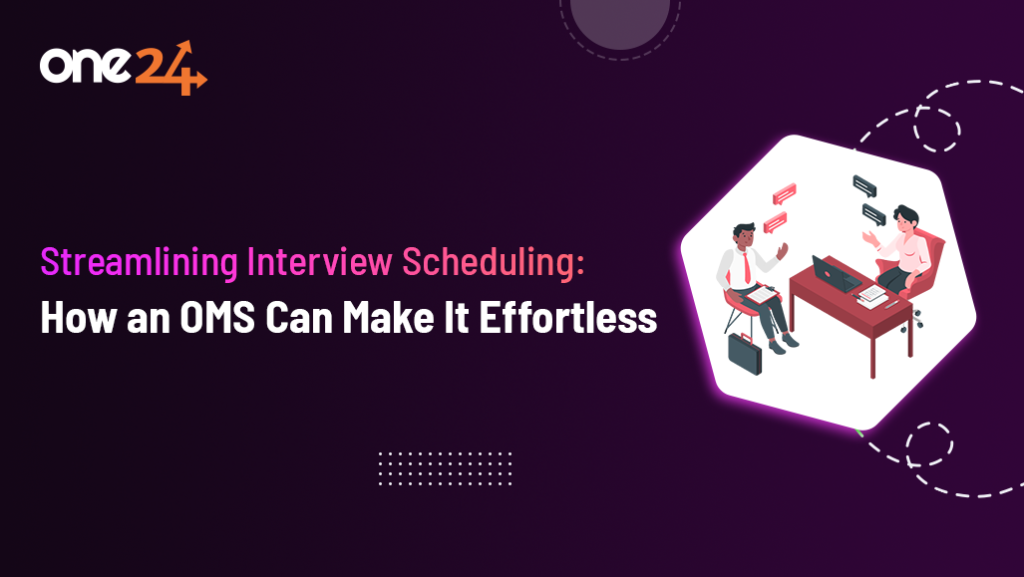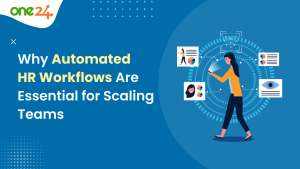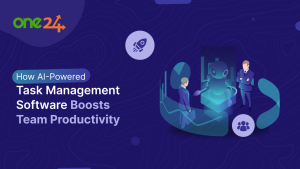It might be difficult to schedule interviews in the hectic world of HR management and recruitment. It can take a lot of time and resources to coordinate availability among interviewers, candidates, and stakeholders while making sure the process runs smoothly. But thanks to the development of cutting-edge technology, especially Organizational Management Systems (OMS) like One24, businesses now have an effective tool for streamlining the interview scheduling procedure.
The Challenge of Interview Scheduling
Candidates, hiring managers, recruiters, and even outside parties like judging panel members or consultants are among the many stakeholders involved in scheduling interviews. Due to the possibility of varying time zones, schedule preferences, and availability among participants, manual coordination is prone to mistakes and delays. These difficulties become more intense when working with scattered teams in different places or in high-volume recruitment situations.

How an OMS Transforms Interview Scheduling
The procedures are optimized by an Organizational Management System, which makes use of automation, data integration, and improved communication routes. It can be made simple with the help of an OMS.
1. Integration of the Calendar and Centralized Scheduling
Recruiters and hiring managers can observe and manage interview timing in real-time on an OMS, which functions as a centralized platform. Stakeholders may access up-to-date availability and schedule it without exchanging emails or phone calls thanks to its seamless integration with calendar apps like Google Calendar, Outlook, and internal HR systems.
2. Computerized Candidate Interaction
After interview times are determined, an OMS initiates applicant correspondence automatically. It lowers the possibility of no-shows and makes sure candidates are notified as soon as possible about the specifics of the interview by sending them individualized invites, confirmation emails, and reminders. Providing concise and timely updates during the process is another way that automated communication improves the candidate’s experience.
3. Personalized Interview Processes
OMS solutions provide configurable workflows based on the requirements of the enterprise. Recruiters can designate phases for interviews, delegate work to team members, and program automated alerts for every phase of the procedure. By ensuring uniformity and transparency, this methodical approach effectively leads interviewers and candidates through the hiring process.
4. Instantaneous Coordination and Evaluation
For recruiting decision-making to be effective, hiring teams must collaborate. An OMS makes it possible for interviewers to give comments right within the platform, facilitating real-time collaboration. Team members can safely exchange candidate notes, and check evaluation forms, which promotes communication and consent over the requirements for evaluating candidates.
5. Analytics and Performance Understanding
An OMS’s data-driven insights improve decision-making and recruitment strategy. Recruiters get access to time-to-hire information, candidate conversion rates, and interview schedule patterns. By using this data, hiring process bottlenecks may be found, resources can be allocated more efficiently, and recruitment tactics can be improved to more successfully draw in top talent.
6. Flexibility and Scalability
OMS adjusts to the needs of an organization as it grows, whether it’s via growing internationally or scaling recruitment efforts for seasonal employment peaks. It facilitates scheduling across many locations, adjusts to various time zones with ease, and supports a variety of styles (panel, in-person, and remote). As operations grow, this scalability guarantees that interview scheduling stays effective and in line with corporate policies.
7. Combining Recruitment and Marketing
Applicant tracking systems (ATS) and recruitment marketing tools can be synchronized with an integrated OMS. The smooth movement of candidate data between platforms made possible by this integration expedites interviews after applications, increasing the effectiveness of recruiting.

Implementation Tips: Adopting an OMS for Interview Scheduling
Organizations should consider the following implementation advice to optimize the advantages:
- Examine Current Procedures: Determine specific improvement goals, pinpoint problem areas, and evaluate the current procedures.
- Choose the Appropriate OMS: Select an OMS solution based on the needs for integration, recruiting volume, and organizational scale. Think about customer support, scalability possibilities, and the usability of the user interface.
- Train and Onboard Users: Ensure that hiring managers, recruiters, and other relevant parties receive thorough training on how to use the OMS efficiently. Ensure that resources and continuing assistance are accessible to answer inquiries and maximize utilization.
- Track Performance Metrics: Keep a close eye on important metrics including candidate feedback scores, interview completion rates, and recruiter productivity. Utilize analytics insights to improve hiring results and process optimization.
Conclusion
There are many advantages for contemporary HR and recruitment procedures when interview scheduling is done through an Organizational Management System. It can improve efficiency, shorten the time to hire, and improve the candidate experience by streamlining scheduling activities, fostering better teamwork among hiring teams, and offering insightful data.
The integration of such a system into the processes is crucial for accomplishing recruitment objectives and preserving competitive advantage in luring top talent, particularly as firms demand agility and effectiveness in recruitment. Accept the transformative potential of this tool and discover how you can easily simplify interview scheduling in your company right now!
People Also Ask
1. In the context of arranging interviews, what is an OMS?
Coordination of availability, automatic communication, and workflow management are just a few of the many components that may be streamlined and automated with the use of an OMS.
2. How is the interview scheduling process enhanced by an OMS?
Tasks related to scheduling are centralized by an OMS, which also automates candidate communication, interacts with calendar apps, and offers real-time updates. This guarantees a more effective and well-organized scheduling procedure by lowering manual labor and minimizing errors.
3. Is it possible for an OMS to interface with current calendar apps?
Yes, an OMS can easily interface with internal HR systems, Google Calendar, Outlook, and other well-known calendar apps, enabling stakeholders to view and control schedules and availability in real-time.
4. How can an OMS improve communication with candidates?
Emails confirming interviews, along with reminders, are automatically sent by an OMS. This lowers the possibility of no-shows and improves the candidate’s experience by guaranteeing prompt and reliable connections with candidates.
5. What opportunities are there for customizing interview workflows in an OMS?
Workflows that can be customized to meet organizational needs are provided by an OMS. Recruiters may guarantee a systematic and uniform process by defining stages, assigning duties, and configuring automated notifications.
6. How might an OMS help hiring teams work together more effectively?
It offers a centralized platform for safe real-time cooperation, enabling interviewers to exchange candidate notes, assessment forms, and comments. This promotes alignment and openness regarding candidate evaluations.
7. What types of analytics are offered by an OMS for arranging interviews?
Recruiters may monitor scheduling trends, evaluate key performance indicators (KPIs), and examine time-to-hire metrics with the use of an OMS’s powerful analytics and reporting features. This data-driven strategy aids in streamlining the hiring procedure.
8. Is an OMS expandable to accommodate expanding businesses?
Yes, as a business expands, an OMS is made to be scalable, able to handle growing recruitment requirements, scheduling across several locations, and different forms (panel, in-person, and remote).
9. How is data security and compliance ensured by an OMS?
Data encryption, audit trails, and role-based access controls are examples of security features found in an OMS. These characteristics guarantee data integrity, confidentiality, and adherence to rules and industry standards.
10. How can businesses begin putting an OMS for interview scheduling into practice?
To maximize utilization and enhance recruitment outcomes, firms implementing an OMS should evaluate their present scheduling procedures, select a suitable OMS solution, train users, and regularly track performance indicators.






